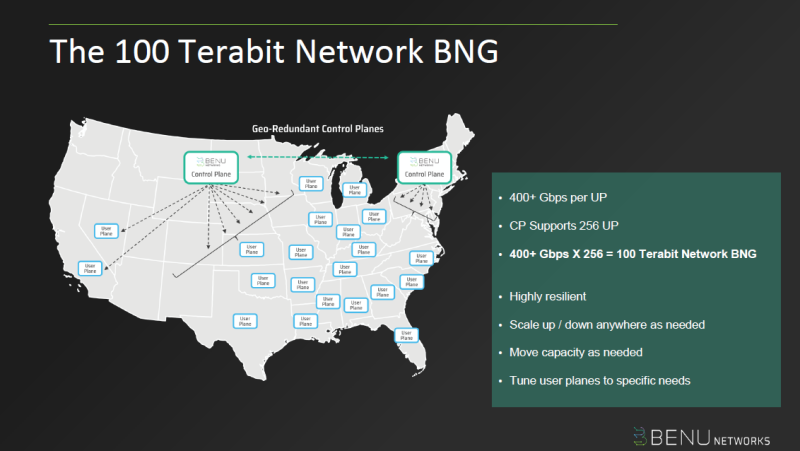Benu Networks has taken its cloud-native broadband network gateway (BNG) to the next level, partnering with Intel to enhance its virtual BNG performance. The companies said the vBNG can reach up to 100 terabits per second (Tbps) of throughput, which can scale to support millions of users.
The benchmark testing was performed using Intel’s third generation Xeon Scalable processors and the company’s Ethernet 800 Series Controller. Alexander Quach, general manager of Intel’s wireline and wireless core networks division, said in a statement Benu’s use of Intel technology delivers the agility and scale service providers require “as they deploy their total cost of ownership (TCO) optimized next generation of converged access infrastructure.”
Benu has been leveraging Intel processors for over seven years, Mike McFarland, Benu Networks' VP of product management and marketing, told Fierce. Intel and Benu's technological collaboration demonstrated capabilities like N+1 redundancy to reduce TCO, geo-redundancy to handle disaster recovery and independent failover of control and user planes – resulting in higher network availability.

The 100-terabit benchmark has given broadband providers the confidence to more broadly adopt a cloud-native BNG architecture, McFarland said, noting that "multiple Tier 1 operators" across multiple continents are deploying cloud solutions for their networks.
"That said, not every operator is ready for 'cloud-native,' so we have a similar solution that is network-appliance based and allows the service provider to evolve to a cloud-native solution when they are ready," he said.
Benu first unveiled its vBNG last year, an architecture targeted at telcos and based on Benu’s software-defined edge (SD-Edge) platform. According to Benu, disaggregated network functions help service providers use the gateway to scale their broadband service securely – within wired, wireless or converged networks.
Typically, hardware based BNGs use application specific integrated circuits (ASICs) for the user plane. Because different ASICs have different interfaces and programming models, it’s difficult to port software from one ASIC to another. That means physical BNGs are limited to what the hardware supports and often can’t make use of technology from multiple vendors.
What differentiates a vBNG like Benu’s from hardware BNGs is the lack of a physical chassis, which limits the number of physical components a BNG can have, such as line cards. Using cloud-native technology, Benu’s vBNG can support up to 256 user planes (per control plane instance) distributed geographically throughout an operator’s network.
McFarland said legacy BNGs typically are limited from 10 to 12 slots. Once all the slots are filled, the operator has to deploy more chassis as well as more control cards and line cards.This can lead to hundreds or even thousands of separate boxes to scale, manage and upgrade.
"Furthermore, these legacy systems are built on vendor-specific hardware and tightly coupled software, which hinders innovation and leads to vendor lock-in," he added.
By not running on a chassis system, Benu's vBNG can operate without scaling limitations, complex redundancy or other issues. The control and user planes are separate, McFarland explained, so that user planes can be easily distributed to the edge to build the footprint for edge computing and more distributed content.
Operators have already begun catching onto disaggregated BNGs. Vodafone last year began testing the Broadband Forum’s TR-459 standard, which enables control plane and user separation (CUPS). That capability allows broadband networks to establish, for instance, a centralized control plane that simplifies subscriber management, management of IP address pools, etc.
In other developments within software-defined networking (SDN), Broadband Forum is working on a technology called dynamic session steering (also known as subscriber session steering). Put simply, the technology uses SDN to reconfigure a user’s connection on the fly based on the application they’re using.